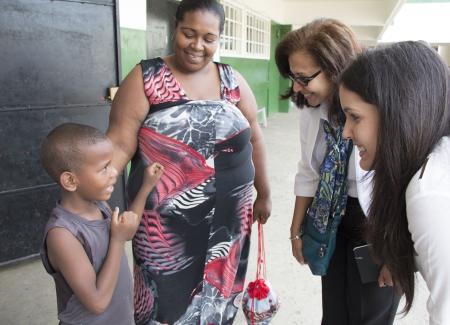Educafuturo: Project to Combat Child Labor Among Vulnerable Populations in Ecuador and Panama by Providing Direct Education and Livelihood Services
Print
Project Objectives: To improve educational outcomes for child and adolescents involved in child labor; and improve family income so that households do not need to rely on the work of children for survival.
The Problem
In Panama, more than 60,000 children are economically active or working while in Ecuador, there are over 155,000 children who are economically active or working. Although Ecuador and Panama have made efforts during the last decade to combat child labor, children remain engaged in the worst forms of child labor, particularly in agriculture, domestic labor, and informal urban labor. These are often Afro-descendant, indigenous and migrant children. Additionally, there are child laborers affected by disabilities whose educational and livelihood options have been compromised.
Our Strategy
Intermediate Objectives:
- Increase access to education and livelihood opportunities for families vulnerable to child labor;
- Provide educational services to reduce child labor and improve educational outcomes for vulnerable children and adolescents;
- Implement livelihood programs and link families to existing programs to improve family income;
- Expand access to education and livelihood opportunities for families affected by child labor and disability;
- Promote effective practices and models to increase access and improve education and livelihood opportunities for families vulnerable to child labor between Ecuador, Panama and other countries.
Summary of Activities:
- Offer accelerated education courses (Espacios para Crecer)
- Enroll adolescents in an education and job promotion program (A Ganar)
- Create links to job training (Panama) • Create links to government small business support (Ecuador)
- Link beneficiaries to microfinance & savings clubs
- Offer vocational training for migrants • Link beneficiaries with government and NGO social protection through “social service fairs”
- Link youth to existing skills-building programs
- To create private sector partnerships to reduce child labor • Conduct supply chain , stake-holder mapping, and value-chain analysis
- Enroll and mainstream disabled children in EPCs, A Ganar, and schools
Targets:
This project targets 6830 beneficiaries which include children, youth, and households. EducaFuturo will reduce hazardous child labor in Ecuador and Panama especially among Afro-descendants, indigenous, migrant populations, and those affected by disabilities. In Panama, the project will be present in Bocas del Toro, Colon, Darien, Panama City and in the comarcas of Ngobe-Bugle and Embera-Wounnan. In Ecuador, the project will be present in Azuay, Cañar, Esmeraldas, and Imbabura, Quito.
Results
As of October 2016, the project has provided education services to 5,953 children and livelihood services to 1,675 households vulnerable to child labor.
Related Learnings
Learn About Our Success

Eight-year-old Emmanuel Pinto does not have an ounce of quit in him. His teachers say, “He has energy to spare.” He loves to write poetry and race over soccer fields.
- Grantee:
- Partners of the Americas
- Implementing Partners:
- COSPAE in Panama, COMUNIDEC, APROTENGB, APRODISO, Expoflores, FUDELA in Ecuador and Fe y Alegria
- Contact Information:
- (202) 693-4843 / Office of Child Labor, Forced Labor, and Human Trafficking (OCFT)
- Tags:
- Child Labor
- Coffee
- Disabilities
- Evaluations
- Livelihoods
- Migrant Populations
- Private Sector
Related Project Resources
- EducaFuturo: Combating child labor in Ecuador and Panama through education, vocational training, and livelihood services
- EducaFuturo: Combatiendo el trabajo infantil en Ecuador y Panamá mediante servicios de educación, capacitación vocacional y medios de vidas.
- Espacios para Crecer - Guía del Facilitador - Águilas y Peces - Etapa Año 2 - EducaFuturo
- Espacios para Crecer - Guía del Facilitador - Águilas - Etapa Año 1 - EducaFuturo
- Espacios para Crecer - Cartilla del Participante - Águilas - Etapa Año 1 - EducaFuturo
- Espacios para Crecer - Guía del Facilitador - Águilas - Etapa Año 2 - EducaFuturo
- Espacios para Crecer - Cartilla del Participante - Águilas - Etapa Año 2 - EducaFuturo
- Espacios para Crecer - Guía del Facilitador - Condores - Etapa Año 1 - EducaFuturo
- Espacios para Crecer - Cartilla del Participante - Condores - Etapa Año 1 - EducaFuturo
- Espacios para Crecer - Guía del Facilitador - Condores - Etapa Año 2 - EducaFuturo
- Espacios para Crecer - Cartilla del Participante - Condores - Etapa Año 2 - EducaFuturo
- Espacios para Crecer - Materias Especiales - Juegos Recreativos, Teatro, Música, Artes Plásticas, Literatura Infantil
- Espacios para Crecer - Cartilla del Participante - Lideres - Etapa Año 1 - EducaFuturo
- Espacios para Crecer - Cartilla del Participante - Lideres - Etapa Año 2 - EducaFuturo
- Espacios para Crecer - Cartilla del Participante - Peces - Etapa Año 1 - EducaFuturo
- Espacios para Crecer - Cartilla del Participante - Peces - Etapa Año 2 - EducaFuturo
- Espacios para Crecer - Guía del Facilitador - Lideres - Etapa Año 2 - EducaFuturo (Ecuador)
- Espacios para Crecer - Guía del Facilitador - Lideres - Etapa Año 2 - EducaFuturo (Panama)
- Espacios para Crecer - Guía del Facilitador - Lideres - Etapa Año 2 - EducaFuturo (B&W)
- Espacios para Crecer - Guía del Facilitador - Lideres - Etapa Año 1 - EducaFuturo (Ecuador)
- Espacios para Crecer - Guía del Facilitador - Lideres - Etapa Año 1 - EducaFuturo (Panama)
